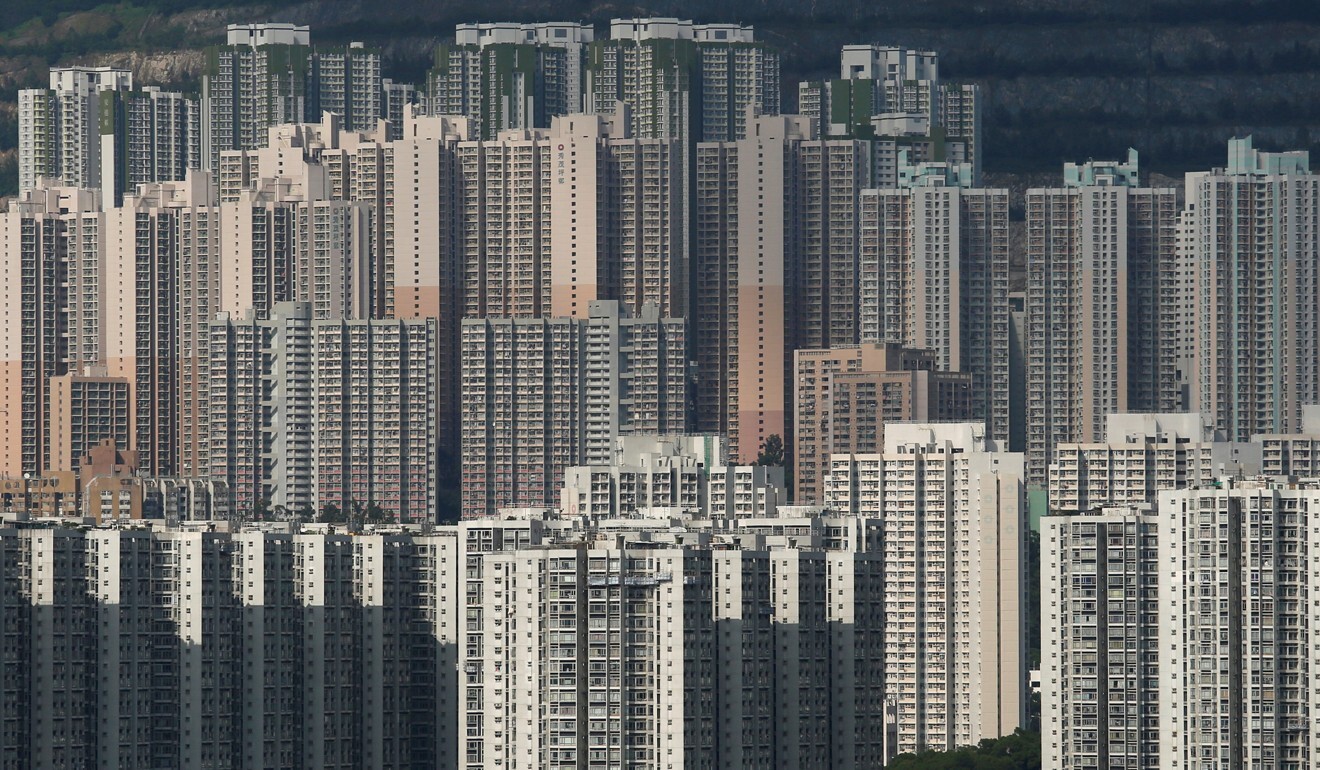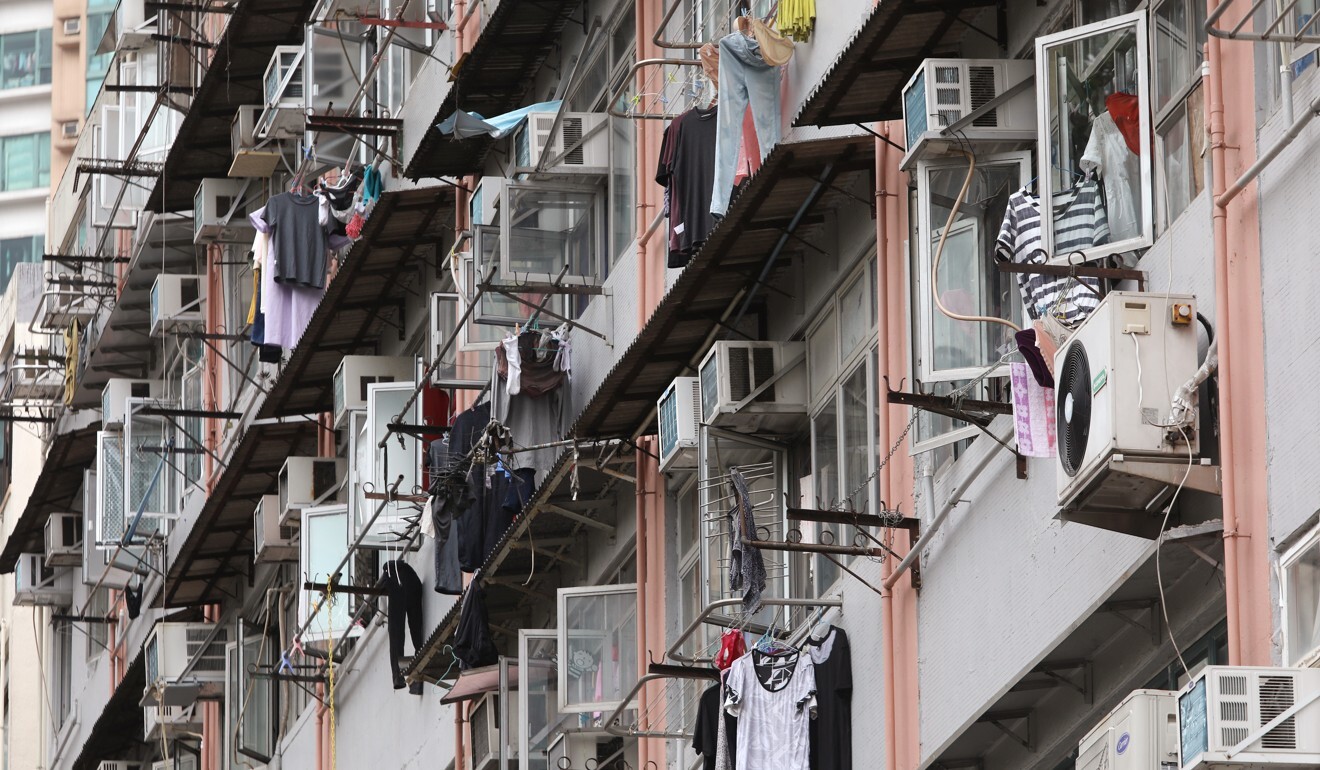
Temperature rising: Hong Kong’s poorest suffer most as city gets hotter, while experts call for action to avoid tragedy
- Even hotter days predicted ahead as spreading urbanisation traps heat in built-up areas, underscoring need for better building designs, more greenery and new habits
- Rapid development has left areas like Sha Tin, with high numbers of low-income and elderly living in public housing, especially vulnerable
Humanity’s need to tackle climate change is more pressing than ever, with the United Nations warning last week that global warming would accelerate at a faster-than-expected pace over the next 20 years. In this four-part series, the Post examines its impact on the city, how the Hong Kong government can best play catch-up, and who is walking the talk in the private sector. Part two looks at the Hongkongers most affected by changing weather patterns. Read part one here.
On Hong Kong’s hottest summer days, housewife Jenny Fung* keeps five fans on at home all day and, like her husband and son, takes multiple showers to try to stay cool.
The family pays HK$5,000 (US$642) a month to rent a 130 sq ft subdivided flat in Kowloon’s Yau Ma Tei neighbourhood.
“I have lived in subdivided units for 10 years, and it has definitely become hotter. This is not normal at all,” said Fung, who shares the tiny space with her husband, a 42-year-old construction worker, and their five-year-old son.

But fear of the coronavirus has kept her at home through this year’s sweltering summer. It has meant monthly electricity bills of up to HK$700, a big chunk of her husband’s monthly pay of just over HK$10,000.
Even with air conditioning, the heat in their flat can be unbearable, and the family is mindful to turn it on only after dinner.
“My son tells me he hates the sun, but all I can tell him is that we’re poor, so he has to study hard to live somewhere better,” Fung said.
Sweltering heat in Hong Kong, extreme weather events worldwide signal need to act
Last month was unusually hot, according to the Hong Kong Observatory, with the average maximum temperature hitting 32.6 degrees Celsius (90.7 Fahrenheit), a full degree hotter than the average from 1991 to 2020.
Seven “very hot weather” warnings were issued in July, when temperatures rose above 33 degrees. The longest stretch lasted more than a week.
Last year was the Earth’s second hottest on record, and in Hong Kong, 11 out of 12 months were warmer than usual, according to the Observatory.
There were 47 “very hot days” and 50 “hot nights”, the highest numbers since Hong Kong began tracking the city’s mean temperature in 1885. Very hot days have a maximum daily temperature of 33 degrees and above, while hot nights are those when the temperature does not fall below 28 degrees.

Research by Hong Kong scientists indicates the city is only likely to get warmer as urbanisation spreads and new public housing estates and developments are created, as it is harder for hot air to disperse in built-up areas.
Increasingly hotter nights also pose a greater risk of death, especially among vulnerable populations such as the elderly and poor, as nighttime heat reduces their bodies’ ability to rest and recover.
Dr Kevin Lau Ka-lun, an assistant professor at Chinese University’s Institute of Future Cities, warned that new towns in Yuen Long, Tin Shui Wai and Tseung Kwan O could expect warmer nights.
Their densely built-up housing areas trap heat during the day and, with fewer green spaces to absorb heat, the nights are no longer as cool as before.
A study he did found that five or more consecutive hot nights could increase the risk of death among women and the elderly.
‘Take action now to avoid tragedy’
Lawrence Iu, climate change and partnerships lead at Civic Exchange, a public policy think tank, said Hong Kong’s infrastructure was currently good enough to withstand the warmer weather for most, but the poor were already feeling a detrimental change.
“For middle-class people, the hotter and drier weather is a slight inconvenience, but for people living in subdivided housing or even local farmers, the impacts are already quite large,” he said.
Hong Kong’s poverty rate has been on the rise, with a government report noting last December the Covid-19 pandemic was likely to affect low-income residents.
“A HK$1,000 utilities bill might not be a huge deal for the average middle-class family, but for a low-income family it is a large dent,” Iu said.
“The resilience of underprivileged communities [to climate change] is really low, but there doesn’t seem to be much being done on this front in Hong Kong at the moment.”
Our newest studies have focused on extreme heat risk ... Cities can continuously accumulate heat, leading to an even more intense heat island effect. The situation is beyond expectations
Dr Ren Chao, a sustainable urban planning expert at the University of Hong Kong, agreed that residents of historically poorer and more densely built-up urban districts were most vulnerable.
She mapped out communities in districts most at risk from the effects of heat between 2006 and 2016 by tracking factors such as age, education level, income level, housing type, population density and those living alone.
She found that older residents were less able to adapt to rising temperatures and recover from heatstroke, while those with lower levels of education knew less about how to reduce their chances of getting heat-related illnesses.
Urban areas with the most vulnerable communities remained consistent throughout the period of the study, and included Choi Hung and Sham Shui Po.
But the rapid development of new towns such as Sha Tin in the New Territories, with high numbers of public rental flats housing lower-income and elderly tenants, have led to those areas rising in heat vulnerability over the decade, her study found.

“Our newest studies have focused on extreme heat risk, which we found has intensified the urban heat island effect,” she said, referring to the phenomenon of heat being retained within cities.
“Cities can continuously accumulate heat, leading to an even more intense heat island effect. The situation is beyond our expectations.”
Ren warned that despite the warning signs Hong Kong was getting warmer, the city did not have an adequate response system in place.
“From all aspects, whether financially or in terms of manpower, it has the foundation to do better and lead,” she said.
She suggested having a comprehensive “heat health action plan” bringing together rescue and social services, and elderly care homes to ensure a quick response to any heat-related illnesses among residents.
Power companies should be included, she said, as hot weather could cause energy demand to surge and lead to power outages if the grid became overloaded.
Hot, hot Hong Kong: sweltering summer days ahead after warmest spring ever
The government’s hot weather warnings should also have a “heatwave” category during prolonged periods of extremely hot days, she added.
“We have the data and expertise, and everybody can definitely feel the heat, but the government response has been relatively slow,” Ren said.
Aside from the weather alerts, Hong Kong also has 19 temporary night heat shelters during the summer intended to provide relief for the city’s street sleepers as well as some tenants of subdivided flats.
The air-conditioned shelters take in people for the night and provide food, water, a mattress and blanket free of charge.
But these are open only from 10.30pm to 8am on days when the Observatory’s “very hot weather” warning remains in force beyond 4.30pm. Social workers have called for more such shelters, and the addition of showers and lockers.
Ren said that across the globe, policy changes had tended to be made only after a tragedy, such as when heatwaves resulted in a high number of deaths in Europe.
“I really do hope not to see a large loss of life in Hong Kong, so if we are aware of the problem, we should be preparing in advance,” she said.

‘Build smarter, learn to keep cool’
Chinese University’s Lau said Hong Kong might avoid a crisis if it built more heat-resilient buildings.
Measures such as setting buildings further back from the road, increasing greenery by growing vertically or on rooftops, and using more permeable materials could help lower temperatures within and around buildings, Lau said.
While older buildings could be retrofitted to improve ventilation, Lau said for poorer residents, learning ways to cool the body instead of the space – such as by wiping themselves with a wet towel or taking more showers – could also help.
The way they set up their fans was also important, he added, suggesting that fans be placed opposite to windows or doors to create a current in the room.
Air conditioning adds to global warming, making us use it more. How to break the cycle
Another way to mitigate the heat island effect is to avoid having buildings with large podiums, a common architectural feature in Hong Kong in which several housing blocks rise above a single large building containing a shopping centre or other businesses.
Squat podium blocks of four to six storeys prevent the circulation of air at ground level. To allow air to circulate and lower the nearby temperature, Lau said the podium blocks could be designed differently, with tunnel-like passageways for example.
“We can build smarter. Our building designs can consider better ventilation and green spaces,” he said. “Imagine if in future, more buildings in Mong Kok are rebuilt in this way, I believe the ventilation and microclimate there will improve.”
Better-designed, cooler buildings will result in lower energy consumption, as less electricity will be needed for air conditioning.
“The main heat source is the sun, so buildings with more shade will be cooler,” Lau said.
However, Hongkongers would still need to change their behaviour, he said. “People should really consider whether they absolutely need to turn on the air-conditioning when sometimes all they need is to switch on a fan and open a window,” he said.

Dr Konstantinos Spandagos, an energy policy researcher formerly with the University of Science and Technology, said people would be more willing to change their habits and save energy if they knew that others around them were doing so as well.
Now with the Economic and Social Research Institute in Ireland, Spandagos said Hong Kong needed to take concrete steps to “make protecting the environment look cool”, something he said could be done by getting local celebrities or influencers to help spread the word.
“This potential remains untapped. Today, there are multiple ways to mobilise social influence through technology and social media,” he said.
For now, however, saving energy seems an impossible task for housewife Fung and her family in their subdivided flat.
“I once tried sleeping with only the fan on to save money, but I woke up completely drenched in sweat in the middle of the night,” she said. “My biggest hope is to get a better public housing unit, but I’ve been on the wait-list for five years.”
*Name changed at interviewee’s request.
The first instalment of this four-part series looks at how human activity is leading to extreme weather patterns, leaving the world vulnerable to floods, forest fires and typhoons.





